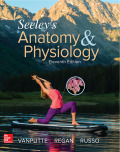
Introduction:
The developing embryo, which starts to develop from a flat sheet of cells, grows to acquire a typical cylindrical shape which takes place through the process of characteristic embryonic folding. The embryo begins to fold laterally and then folds at both the ends, forming a distinct C-shape with a distinct head and tail end.
Answer to Problem 1RAC
The correct answer is option (b) weeks 3-8 of development.
Explanation of Solution
Explanation/justification for the correct answer:
Option (b) weeks 3-8 of development. The major organ system development takes place during the 5th week of embryonic development. The neural tube starts forming, and the embryo is surrounded by amniotic fluid. The major organ system like the nervous system (brain and spinal cord) and heart are formed. So, the correct answer is option (b).
Explanation for incorrect answer:
Option (a) week 1 and 2 of development. The major organ system is not developed during 1st and 2nd week, as the zygote gets implanted during the first two weeks and forms embryonic and placental structures. So, this is an incorrect option.
Option (c) weeks 8-20 of development. During 8-20 weeks of development most of the organ systems have been formed, and the nerve centers start forming senses through rapid brain growth. The layers of skin also start to form. So, this is an incorrect answer.
Option (d) the last 30 weeks of development. During last 30 weeks of development the brain of the fetus is still growing, and the red blood cells start to form in the bone marrow, and the bones also start to harden. So, this is an incorrect answer.
Want to see more full solutions like this?
Chapter 29 Solutions
EBK SEELEY'S ANATOMY & PHYSIOLOGY
- please draw in the answers, thank youarrow_forwarda. On this first grid, assume that the DNA and RNA templates are read left to right. DNA DNA mRNA codon tRNA anticodon polypeptide _strand strand C с A T G A U G C A TRP b. Now do this AGAIN assuming that the DNA and RNA templates are read right to left. DNA DNA strand strand C mRNA codon tRNA anticodon polypeptide 0 A T G A U G с A TRParrow_forwardplease answer all question below with the following answer choice, thank you!arrow_forward
- please draw in the answeres, thank youarrow_forwardA) What is being shown here?B) What is indicated by the RED arrow?C) What is indicated by the BLUE arrow?arrow_forwardPlease identify the curve shown below. What does this curve represent? Please identify A, B, C, D, and E (the orange oval). What is occurring in these regions?arrow_forward
- Please identify the test shown here. 1) What is the test? 2) What does the test indicate? How is it performed? What is CX? 3) Why might the test be performed in a clinical setting? GEN CZ CX CPZ PTZ CACarrow_forwardDetermine how much ATP would a cell produce when using fermentation of a 50 mM glucose solution?arrow_forwardDetermine how much ATP would a cell produce when using aerobic respiration of a 7 mM glucose solution?arrow_forward
- Determine how much ATP would a cell produce when using aerobic respiration to degrade one small protein molecule into 12 molecules of malic acid, how many ATP would that cell make? Malic acid is an intermediate in the Krebs cycle. Assume there is no other carbon source and no acetyl-CoA.arrow_forwardIdentify each of the major endocrine glandsarrow_forwardCome up with a few questions and answers for umbrella species, keystone species, redunant species, and aquatic keystone speciesarrow_forward
 Human Biology (MindTap Course List)BiologyISBN:9781305112100Author:Cecie Starr, Beverly McMillanPublisher:Cengage Learning
Human Biology (MindTap Course List)BiologyISBN:9781305112100Author:Cecie Starr, Beverly McMillanPublisher:Cengage Learning Nutrition Through The Life CycleHealth & NutritionISBN:9781337919333Author:Brown, Judith E.Publisher:Cengage Learning,
Nutrition Through The Life CycleHealth & NutritionISBN:9781337919333Author:Brown, Judith E.Publisher:Cengage Learning, Human Heredity: Principles and Issues (MindTap Co...BiologyISBN:9781305251052Author:Michael CummingsPublisher:Cengage Learning
Human Heredity: Principles and Issues (MindTap Co...BiologyISBN:9781305251052Author:Michael CummingsPublisher:Cengage Learning Biology: The Unity and Diversity of Life (MindTap...BiologyISBN:9781305073951Author:Cecie Starr, Ralph Taggart, Christine Evers, Lisa StarrPublisher:Cengage Learning
Biology: The Unity and Diversity of Life (MindTap...BiologyISBN:9781305073951Author:Cecie Starr, Ralph Taggart, Christine Evers, Lisa StarrPublisher:Cengage Learning Biology (MindTap Course List)BiologyISBN:9781337392938Author:Eldra Solomon, Charles Martin, Diana W. Martin, Linda R. BergPublisher:Cengage Learning
Biology (MindTap Course List)BiologyISBN:9781337392938Author:Eldra Solomon, Charles Martin, Diana W. Martin, Linda R. BergPublisher:Cengage Learning





